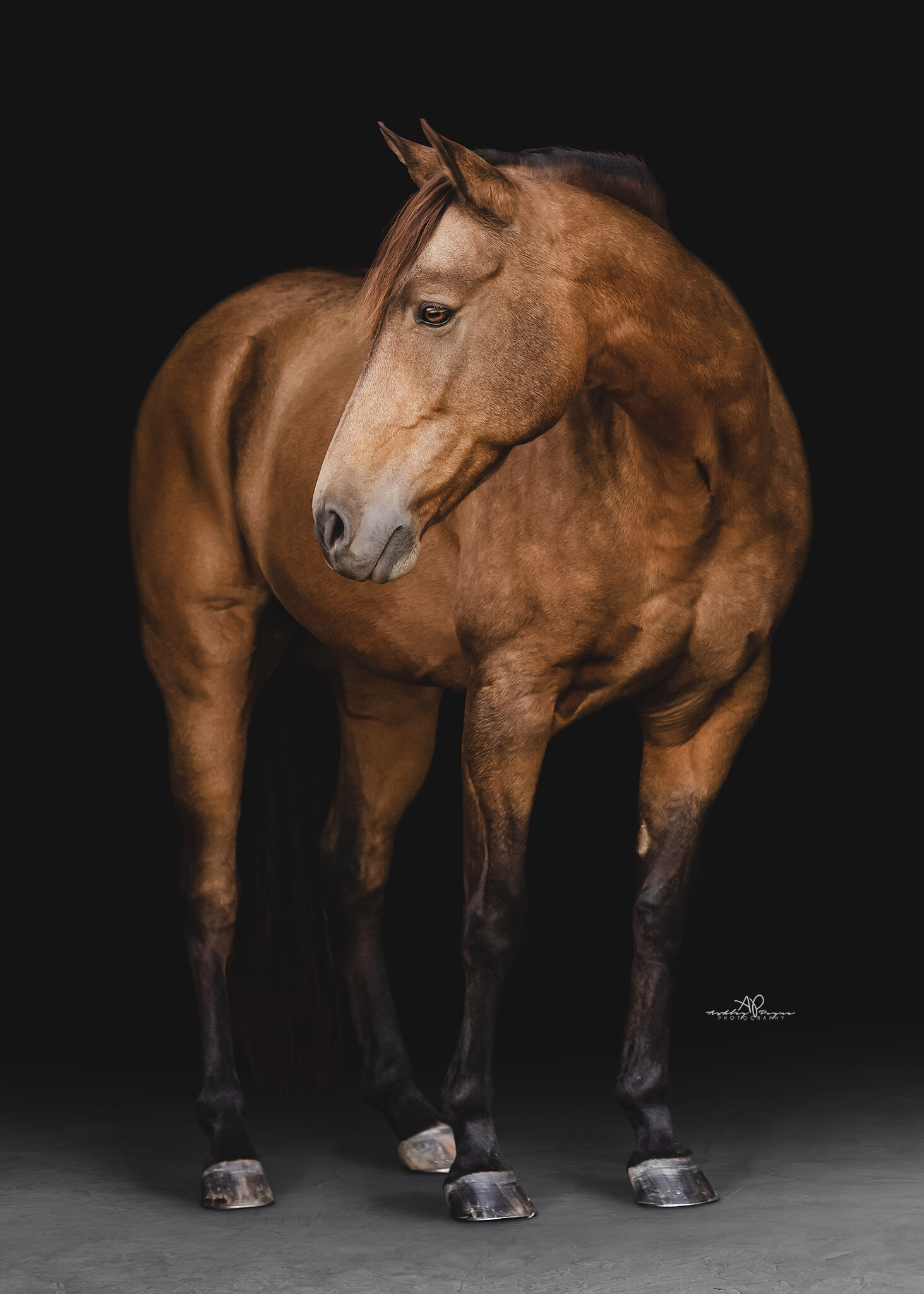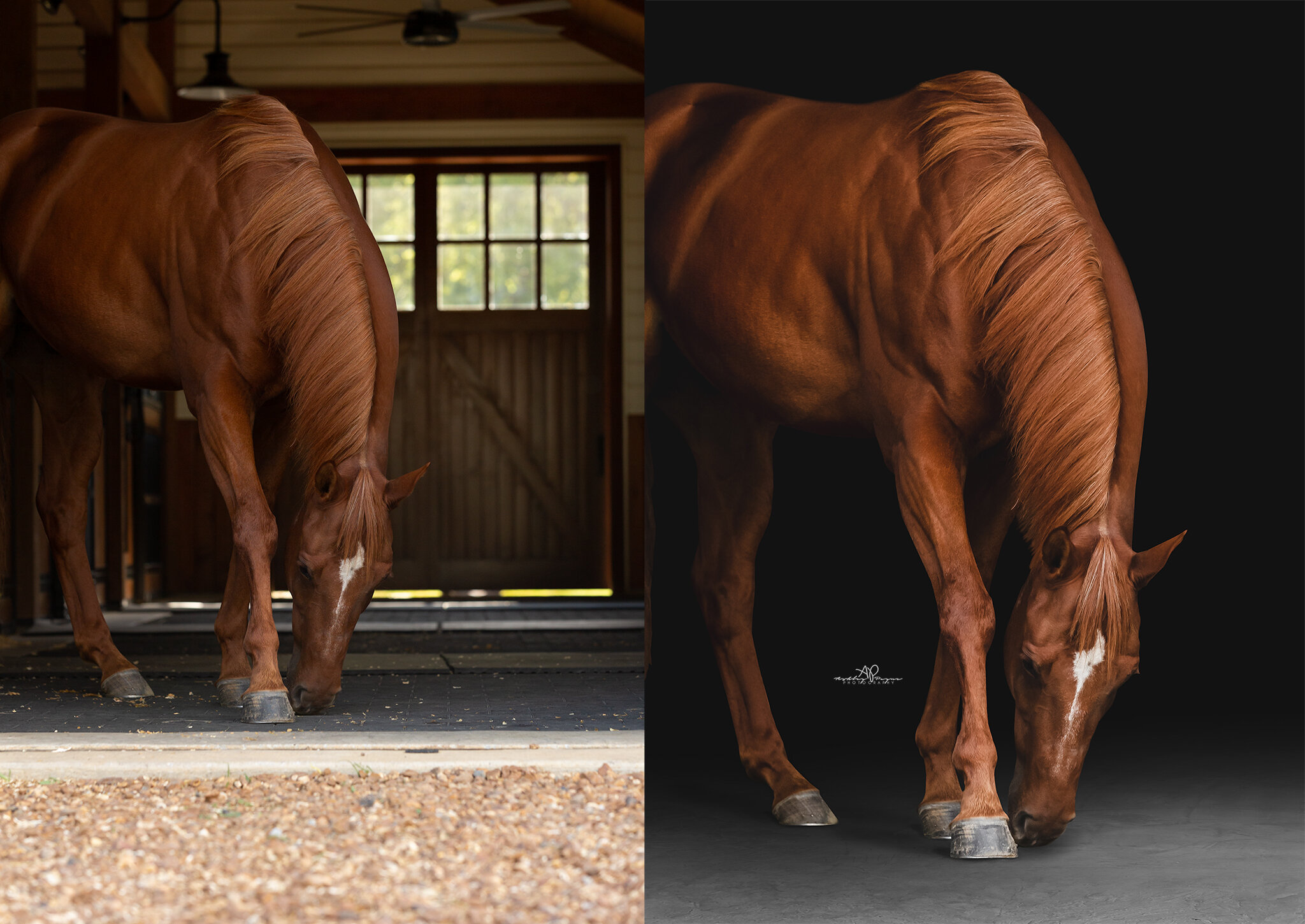How I edit fine-art Black Background Equine Portraits (+ Before & Afters)
How I edit fine-art black background equine portraits
+ tips for equine photographers
Ever wondered how I photograph and edit black background equine portraits? If so, this post is for you!
If you’ve been a part of an equine portrait session, you likely remember it resembling something along the lines of a well-organized circus. You probably had a few extra helping hands close by to make sure your horse looks spiffy for their big day. Oh, and don’t forget the photographer’s assistant that was somewhere in the mix -- making sure ears were forward, fixing manes, helping with posing, crinkling plastic baggies, and using whinny sounds, all for the sake of making sure your horse looks like an upcoming model for the cover of EQUUS.
But wait. There’s more!
Photographing horses is only the first step in creating equine portraits. The next step is where the magic begins. If I’ve done my job well, you’ll have a hard time telling what kind of magic went on to create the finished portrait. Black background portraits can be done numerous ways. I prefer to edit with a fine-art style paying careful attention to detail to achieve an overall aesthetic of an elegant and timeless portrait. When editing, I always aim for the following three things: elegance, smoothness, shadows that match the ambient light, and a subject that is free from distractions (i.e uneven floor or discolored floor, debris on floor, noticeable blemishes, etc.).
I use a combination of Lightroom and Photoshop to create fine-art equine portraits. I begin by removing all distractions: extra people, lead ropes, halters, blemishes, feed pans, hay, bugs, grass stains, flyaway hair, and I often times have to repaint certain sections of hair back in strand by strand. Once the portrait has been retouched, I create a clipping path around the horse so that I can edit it separately from the background and floor. Next I create a black background layer, ensuring that it is straight and well-blended. If the original barn floor is uneven in texture or has a lot of noticeable debris, I replace the entire floor for a cleaner overall look. Next, I hand-paint shadows back into the portrait and carefully mimic the original shadowing beneath the horse so that the floor replacement looks realistic and the horse does not appear to be floating.
Once I’ve completed most of the extensive editing in Photoshop, I bring the portrait into Lightroom and adjust lighting and color to bring out the best tones in the portrait. After achieving an aesthetically balanced image, I apply my signature fine-art finish to the portrait and then save three different file types for the portrait. One for web, one for printing wall art, and one Photoshop Layers Document (PSD) in case I want to revisit the image again later for further adjustments.
The overall process for editing black background equine portraits is quite extensive, but those gorgeous portraits hanging on the wall in my client’s homes make the weeks of editing worth it!
Here’s a few more black background portrait before and after transformations + editing tips for equine photographers:
Although the floor in this barn is beautifully designed, it is not ideal for the traditional clean concrete look that I often go for when editing full body equine portraits.
Editing Tip: Replace the floor for a cleaner appearance. Hand-paint shadows back into the portrait so that the horse does not appear to be floating. Be careful to paint your shadows according to the direction of the light so that they look realistic.
When horses look behind them, depending on the angle, you can often see the sclera (white portion of the eye).
Editing Tip: Edit the sclera out for a more relaxed appearance.
As an equine photographer, I am often at the mercy of the horse. Some shots that I take are far from perfect, and that is okay!
Editing Tips: If you have a shot that is crooked, straighten it with the ruler tool BEFORE you begin editing. This will be helpful in achieving straightness with both your horse and black background. Some tails like the one above can be tricky to edit around. You may find it helpful to paint the tail on a new layer in Photoshop. To do this, I erase the existing tail, and paint a new tail onto a new layer. If I need to adjust the color or brightness, I add an adjustment layer to the tail layer and tweak until it matches the overall portrait lighting and color.
LEARN HOW TO EDIT FINE-ART Black Background EQUINE PORTRAITS
the fine-art black background course will be released on the Education page! 😉
A basic knowledge of Lightroom and Photoshop is recommended, however, all courses will be an easy-to-follow, step-by-step walkthrough of how to transform a RAW photograph into a beautiful fully edited fine-art portrait. In the course you’ll be learning my full editing process including, but not limited to:
》How I photograph black backgrounds and what camera settings I use
》Culling + Lightroom workflow
》Adjusting color, light and temp on out-of-camera RAW images in Lightroom before importing to photoshop
》How to work with layers and layer masks
》How to create a black background with a smooth transition to the floor
》How to completely replace a floor AND how to retouch an existing floor
》How to repaint original shadows after replacing the floor
》How to retouch skin, blemishes, remove objects, and replace legs and ears
》How to color-correct in photoshop
》How to hand-paint eyes for a studio look
》How to achieve a fine-art finish for your final portrait
》How to create your own actions, presets and brushes to save time while editing
》How to export files so that they look great on social media
》How to export files for artwork prints
》How to save your work in Photoshop so that you can make changes later
》How to get your finished Photoshop image to automatically sync and appear in your Lightroom gallery
BONUS TOPICS included to elevate your client experience, printed artwork, and editing workflow:
》Wall Mockups + How wall mockups can increase your artwork sales
》Monitor calibration & best monitor settings for editing
》How to achieve accurate color and tone in your prints
》The importance of finding a workflow that works for you
And one more really exciting surprise that I think you guys will love! Without giving too much away... After you've finished the course, you'll have the opportunity to ask questions, receive feedback, share your work, and have some laughs. More on that soon though! 😉
If you'd like to be notified when the course is released, sign up via my Education page here:





